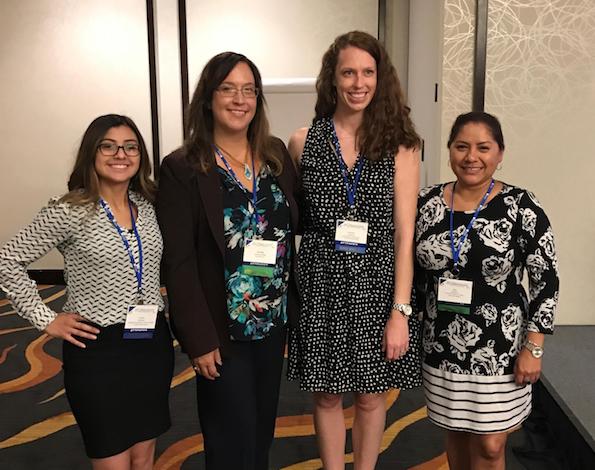Students Attend Professional Mathematics and Math Education Conferences
The future of mathematics education got a little brighter this year as teachers-to-be attended multiple professional events and workshops with their faculty mentors. Students also attended and presented at the regional Mathematical Association of America Conference.
California Mathematics Council North Conference
 Future elementary school teachers Emily Tom, Sky Griffin and David Gutierrez attended the 2017 California Mathematics Council North Conference for mathematics teachers and educators. They were joined by Maria Ramirez and Hayley Cushing, future secondary mathematics teachers, whose travel was supported by the Noyce Scholarship NSF grant. The students — from math, liberal studies and the single subject mathematics credential — attended talks and participated in discussions about K-12 mathematics in our state.
Future elementary school teachers Emily Tom, Sky Griffin and David Gutierrez attended the 2017 California Mathematics Council North Conference for mathematics teachers and educators. They were joined by Maria Ramirez and Hayley Cushing, future secondary mathematics teachers, whose travel was supported by the Noyce Scholarship NSF grant. The students — from math, liberal studies and the single subject mathematics credential — attended talks and participated in discussions about K-12 mathematics in our state.
Elsa Medina and Amélie Schinck-Mikel led a workshop titled Fun with Algebraic Thinking at the conference.
Noyce Scholars

Fifty Noyce Scholars from Cal Poly and other universities attended. The workshop is funded by a National Science Foundation grant that provides $12,000 or $24,000 scholarships to future mathematics teachers who make a commitment to teach in a high needs school district. Participants also receive $800 for attending the summer workshops.
Research on Undergraduate Mathematics Education Conference

Cal Poly Math Academy
 The sixth annual Cal Poly Math Academy, directed by Elsa Medina and Amélie Schinck-Mikel, welcomed more than 40 Hispanic students from local high schools to campus last summer. For one week, students solved challenging mathematical problems through hands-on activities. The academy, which is supported by the College of Science and Mathematics, aims to inspire students to pursue careers in STEM fields and to see and enjoy the beauty of mathematics.
The sixth annual Cal Poly Math Academy, directed by Elsa Medina and Amélie Schinck-Mikel, welcomed more than 40 Hispanic students from local high schools to campus last summer. For one week, students solved challenging mathematical problems through hands-on activities. The academy, which is supported by the College of Science and Mathematics, aims to inspire students to pursue careers in STEM fields and to see and enjoy the beauty of mathematics.
Golden Section of the Mathematical Association of America Conference
 Students Tim Wetzel and Perrin Silveira and professors Jonathan Shapiro and Rebecca Bishop attended the annual meeting of the Golden Section of the Mathematical Association of America Conference held at CSU East Bay. The Golden Section includes Northern California, Northern Nevada and Hawaii.
Students Tim Wetzel and Perrin Silveira and professors Jonathan Shapiro and Rebecca Bishop attended the annual meeting of the Golden Section of the Mathematical Association of America Conference held at CSU East Bay. The Golden Section includes Northern California, Northern Nevada and Hawaii.
Wetzel presented a poster on his research findings on two ways to reduce noise in data. His advisor on the project was Professor Paul Choboter.
Wetzel's Abstract
Data transforms are used to put data into a different format, in order to manipulate it in ways impossible to achieve in its original form. These types of transformations are commonly used to “denoise”, or reduce noise in, data. This report examines two types of data transforms — the Fast Fourier Transform (FFT) and the Discrete Wavelet Transform (DWT) — and analyzes which is more effective at improving distorted signals. In this report, two signals were tested:
- Signal 1: a 20-second song clip of ‘Gotta Go’ by The Incrementals synthetically dis- torted with noise generated by matlab’s rand() function
- Signal 2: a seismic signal of a Mw9.0 earthquake originating in Tohoku-Oki, Japan on March 11, 2011, which includes noise organically
Preliminary research indicated that FFT is more accurate when analyzing sound waves due to the periodic nature of the transform, and that DWT is more accurate when analyzing data composed of discrete, unlinked data points. FFT is described as the faster method in all instances. In this report’s experiments, this proved true. FFT was measurably faster for both signals, and measurably more accurate for the sound signal. While it was impossible to quantify accuracy against an original seismic signal by the nature of that type of data, DWT was qualitatively more accurate than FFT in this case.

